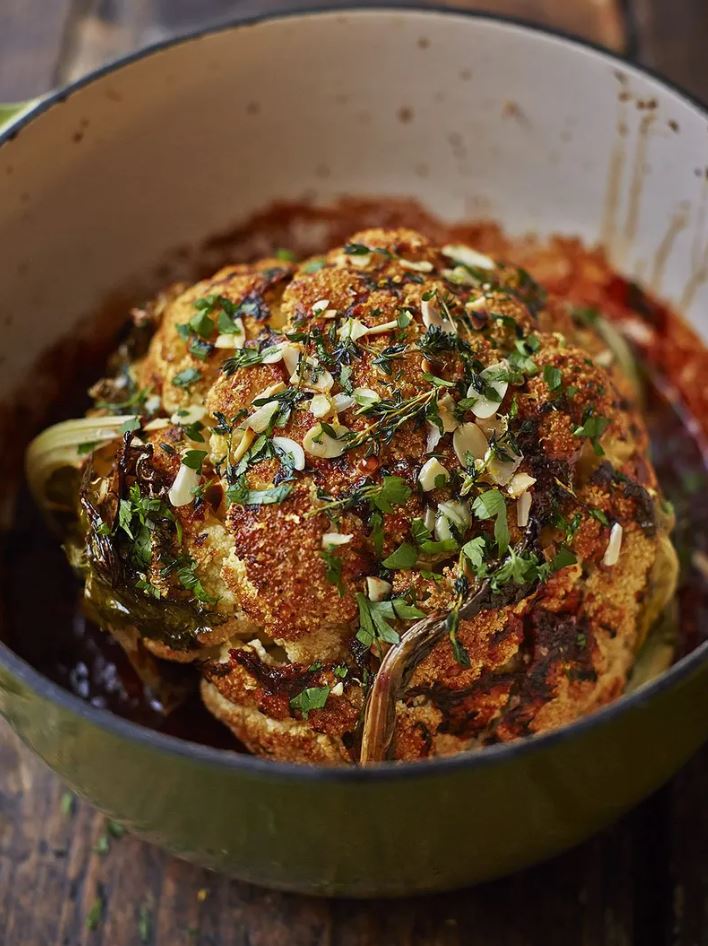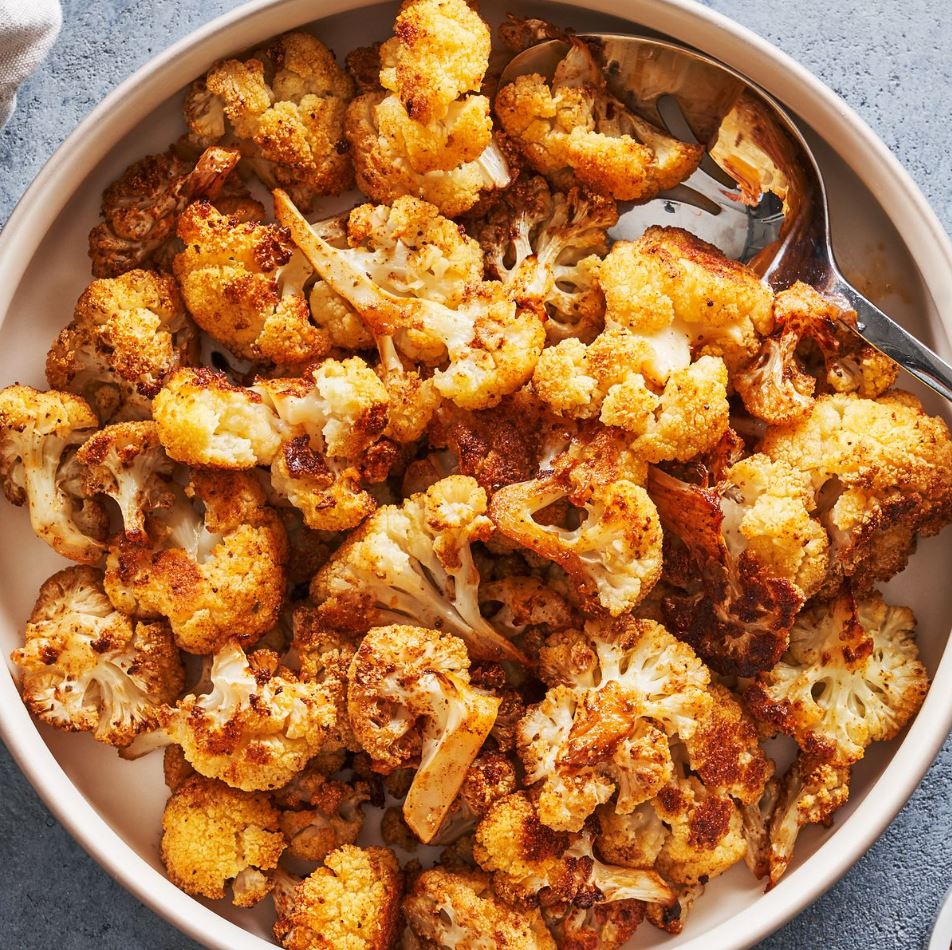Delicious Cauliflower Roasted Recipe for Any Occasion
This cauliflower roasted recipe proves that roasting can transform the humble cauliflower into a culinary masterpiece, enhancing its natural sweetness and nutty flavors. With minimal ingredients and simple techniques, this oven-roasted cauliflower becomes a versatile and universally appealing addition to any menu. By combining cauliflower with just a few seasonings, along with oil and butter, this recipe is not only straightforward to prepare but also yields a dish that’s both delicious and satisfying.
The appeal of this roasted cauliflower recipe lies in its accessibility and adaptability. Whether you’re a seasoned chef or a novice in the kitchen, the process is forgiving and the results are consistently impressive. The basic requirements—cauliflower, oil, butter, and simple seasonings—are typically pantry staples in many households, making this dish an excellent last-minute option for busy weeknights or spontaneous gatherings.
Moreover, oven-roasted cauliflower appeals to a wide range of dietary preferences and restrictions, fitting seamlessly into vegan, vegetarian, and gluten-free diets when the appropriate adjustments are made. Its versatility doesn’t stop there; this cauliflower can be a perfect side dish, a robust addition to salads, or even a hearty main course when paired with more substantial ingredients.
This recipe not only delivers on taste and ease but also offers a canvas for creativity in the kitchen. By adjusting the seasonings or adding ingredients like cheese or herbs in the final stages of cooking, you can customize the dish to suit different palates and occasions. As we delve deeper into the method and variations of this recipe, you’ll discover just how simple and satisfying roasting cauliflower can be, making it a reliable and enjoyable option for any meal.
| Aspect | Details |
|---|---|
| Recipe Overview | A simple, versatile recipe that enhances the natural sweetness and nutty flavors of cauliflower. Requires minimal ingredients such as cauliflower, oil, butter, and basic seasonings. |
| Accessibility and Adaptability | Easy to prepare, making it suitable for both seasoned chefs and novices. Ingredients are common pantry staples, allowing for quick assembly and adaptability to various dietary needs. |
| Diet Compatibility | Fits a wide range of dietary preferences including vegan, vegetarian, and gluten-free diets when appropriate substitutions are made (such as using plant-based butter). |
| Versatility in Use | Can be served as a side dish, added to salads, or used as the main course with additional proteins or hearty ingredients. Offers a canvas for culinary creativity, adaptable to different seasonings or additional toppings like cheese or herbs. |
| Preparation Simplicity | The recipe involves simple roasting techniques that are forgiving and yield consistent results, making it an ideal option for busy schedules and last-minute meal planning. |
Contents
Ingredients and Tools
Creating a delicious, oven-roasted cauliflower dish begins with gathering the right ingredients and ensuring you have the necessary kitchen tools. This recipe focuses on simplicity and flavor, utilizing everyday items that combine to produce a dish full of texture and taste. Here’s what you’ll need:

Ingredients
Cauliflower: One large head, fresh. Ensure it’s clean and free from blemishes, as the quality of your cauliflower will greatly influence the dish’s final flavor and texture.
Olive Oil: For drizzling. Olive oil is chosen for its health benefits and its ability to withstand the high heat needed for roasting, which helps in creating a crispy, caramelized exterior while keeping the inside tender.
Butter: This enhances flavor and aids in the caramelization of the cauliflower. The combination of olive oil and butter ensures that each floret is richly coated and develops a beautifully golden color as it cooks.
Seasonings
- Fine Sea Salt: Adds necessary seasoning and brings out the natural flavors of the cauliflower.
- Freshly Cracked Black Pepper: Provides a subtle spice and depth.
- Garlic Powder or Garlic Salt: Adds a warm, aromatic flavor that pairs perfectly with the nuttiness of the cauliflower.
- Paprika: Not only does paprika add a lovely hint of color, but it also offers a mild sweetness with a touch of earthy flavor, enhancing the overall taste profile.
Optional
Parmesan Cheese: About 1/2 cup, shredded. Adding cheese is optional but recommended for a savory, cheesy crust that complements the natural flavors of the cauliflower. Parmesan is ideal for its salty, nutty flavor and its ability to melt beautifully into a golden topping.
Tools Needed
Oven: The primary cooking method here is roasting, which requires a reliable oven capable of maintaining high temperatures.
Baking Sheet: Choose a sturdy baking sheet that can accommodate the cauliflower in a single layer without overcrowding, allowing for even cooking and caramelization.
Parchment Paper: Using parchment paper not only makes cleanup easier but also prevents sticking, ensuring that the cauliflower roasts perfectly without losing its delicious crust to the pan.
Knife and Cutting Board: A sharp knife is essential for cutting the cauliflower into even florets or steaks, which promotes uniform cooking. A stable cutting board will also provide a safe cutting surface.
Preparation Tips
Cauliflower Prep: Remove the leaves and trim the stem of the cauliflower, then cut it into uniform pieces, whether florets or steaks, depending on your preference. Uniformity is key to ensuring that all pieces roast at the same rate.
Oil and Butter: Mixing olive oil and melted butter together before drizzling it over the cauliflower helps to evenly coat each piece. This mixture not only adds flavor but also aids in achieving a deliciously crispy texture.
Seasoning: After drizzling with the oil and butter, sprinkle the seasonings evenly to cover all pieces. If using garlic salt instead of garlic powder, you may want to adjust the amount of fine sea salt to avoid overly salting the dish.
Cheese: If you choose to add parmesan cheese, sprinkle it during the last 5 minutes of roasting to avoid burning the cheese, allowing it to melt into a golden crust.
This combination of ingredients and tools sets the stage for a roasted cauliflower dish that is as easy to prepare as it is delightful to eat. Whether served as a side or a main dish, its versatility and deliciousness are sure to impress.
| Category | Details |
|---|---|
| Ingredients |
|
| Tools Needed |
|
| Preparation Tips |
|
Recipe Steps for Easy Oven-Roasted Cauliflower
Creating a delicious oven-roasted cauliflower dish is both straightforward and rewarding. This recipe guides you through each step from preparing the cauliflower to serving it with optional variations for added flavor. Here’s how to make your cauliflower not just edible, but delectable.
Preparing the Cauliflower
Preheat the Oven: Begin by heating your oven to 425˚F. This high temperature is crucial for achieving a beautifully caramelized exterior while keeping the inside tender but firm.
Prepare the Baking Sheet: Line your baking sheet with parchment paper. This helps prevent sticking and ensures easy cleanup. Make sure the sheet is large enough to accommodate the cauliflower in a single layer.

Cut the Cauliflower: Wash the cauliflower head and pat it dry. Remove the outer leaves and trim off any brown spots on the surface. Depending on your preference, cut the cauliflower into uniform florets or slice it into steaks. For florets, cut into small or medium pieces that will cook evenly. For steaks, slice the head vertically into about ½-inch thick slices. This not only looks impressive but also provides flat surfaces that caramelize nicely against the heat of the baking sheet.
Seasoning
Mix Ingredients: Place the cut cauliflower on the prepared baking sheet. Drizzle with olive oil and melted butter, ensuring each piece is well-coated. This fat not only adds flavor but also helps the seasoning adhere to the cauliflower and aids in caramelization during baking.
Add Seasonings: Sprinkle fine sea salt, freshly cracked black pepper, garlic powder (or garlic salt if preferred), and a light dusting of paprika over the cauliflower. These seasonings enhance the natural flavors of the cauliflower while adding a layer of complexity with their aromatic and spicy notes.
Arrange for Baking: Toss everything well to ensure each piece is evenly coated with the oil, butter, and seasonings. Then, spread the cauliflower in a single layer across the baking sheet. Avoid overcrowding, as this can lead to steaming rather than roasting, which might prevent the edges from becoming crisp and golden.
Baking
Bake: Place the baking sheet in the preheated oven and roast for 15-25 minutes. The exact cooking time will depend on the size and thickness of the cauliflower pieces. Smaller florets may need only 15 minutes, while larger steaks could require up to 25 minutes. You’re aiming for a crisp-tender texture, with edges that are golden brown and slightly crispy.
Variations
Cheese Option: For a cheesy twist, sprinkle about 1/2 cup of shredded parmesan cheese over the cauliflower in the last 5 minutes of baking. This will result in a deliciously melty and slightly crispy topping that adds a rich, savory element to the dish.
Cauliflower Steaks: If you’ve chosen to make cauliflower steaks, pay extra attention to the initial cutting. Ensure each steak is evenly sliced to promote uniform cooking. As they roast, the flat sides of the steaks will caramelize beautifully, creating a depth of flavor and a satisfying texture that’s both tender and crisp.
By following these steps, you can master the art of roasting cauliflower, transforming a simple vegetable into a gourmet-worthy dish. Whether you prefer the classic simplicity of seasoned florets or the hearty appeal of roasted cauliflower steaks, this recipe provides a foundation for a multitude of delicious meals. Enjoy it as a side dish, incorporate it into salads, or serve it as a vegetarian main course – the possibilities are endless.
| Preparation Phase | Instructions |
|---|---|
| Preparing the Cauliflower |
|
| Seasoning |
|
| Baking | Roast in the preheated oven for 15-25 minutes, until the edges are golden brown and the texture is crisp-tender. |
| Variations |
|
Cooking Tips for Oven-Roasted Cauliflower
Preparing a dish like oven-roasted cauliflower involves more than just following a recipe—it’s about mastering a few key techniques and understanding how to adjust flavors and cooking methods to suit your personal taste and dietary preferences. Here, we delve into the essentials of slicing, seasoning, and employing alternative cooking methods such as using an air fryer.
Slicing Techniques
1. Cutting Florets: To cut cauliflower into florets, start by removing the leaves and any part of the stem that seems too tough. Place the cauliflower with the base flat on a cutting board. Using a sharp knife, cut around the core to remove it. You should then be able to pull apart the large florets with your hands. For more uniform pieces, place each large floret on the board and slice through the stem to divide it into smaller, bite-sized florets. This method ensures that each piece will cook evenly, optimizing the texture and flavor.
2. Making Cauliflower Steaks: For cauliflower steaks, keep the core intact as it helps hold the slices together. Place the cauliflower head on its base, and use a large knife to slice it into approximately 1/2-inch thick steaks from the top down. This might yield three to four good steaks per head, depending on its size. The outer slices will not hold together as well, but these can be roasted alongside the steaks or saved for another use, such as making cauliflower rice.

Seasoning Suggestions
The beauty of cauliflower is its mild flavor, which makes it a wonderful canvas for a variety of seasonings. Here are a few ideas:
1. Basic Seasoning: A simple combination of olive oil, salt, and pepper is timeless and allows the natural flavor of the cauliflower to shine through. This is perfect for those who prefer a lighter taste or are adding the cauliflower to a dish with other prominent flavors.
2. Savory Seasoning: For a savory kick, add garlic powder and onion powder to the mix. You can also sprinkle some dried herbs like thyme or rosemary. These seasonings complement the nuttiness of roasted cauliflower beautifully.
3. Spicy Version: If you enjoy a bit of heat, consider adding a sprinkle of red pepper flakes or a dash of cayenne pepper along with the basic seasonings. This version goes great with a cooling dip like tzatziki or a yogurt-based sauce.
4. Cheesy Delight: As mentioned earlier, adding grated parmesan or another hard cheese like Asiago in the last few minutes of roasting can add a wonderful depth of flavor and a crispy texture.
Alternate Cooking Methods
Using an air fryer is an excellent alternative to oven roasting, especially if you’re short on time or cooking for a smaller number of people.
1. Settings: Preheat your air fryer to 375˚F. This slightly lower temperature compared to oven roasting helps prevent the outside of the cauliflower from burning before the inside is cooked through.
2. Process: Since air fryers circulate hot air around the food, it’s best to skip the butter to avoid smoking and use just olive oil. Toss your cauliflower florets or steaks in olive oil and your chosen seasonings. Place them in the air fryer basket in a single layer, ensuring they aren’t overcrowded to promote even cooking. Cook for 10-15 minutes, flipping the florets or steaks halfway through. The exact time will depend on the size of your cauliflower pieces and your specific air fryer model.
3. Benefits: The air fryer method reduces the cooking time significantly and often results in a crispier texture. It’s also an energy-efficient alternative to heating up your oven, especially beneficial for small batches or during warmer months.
By mastering these techniques and understanding how to adapt the cooking methods, you can enjoy perfectly cooked cauliflower that suits your taste and dietary needs. Whether roasted in an oven or air fryer, cauliflower remains a versatile and nutritious option for any meal.
| Technique/Method | Details |
|---|---|
| Slicing Techniques |
|
| Seasoning Suggestions |
|
| Alternate Cooking Methods |
|
Storage and Reheating of Oven-Roasted Cauliflower
Oven-roasted cauliflower is not only a versatile and delicious dish when freshly made but also holds up well for future meals, making it a perfect candidate for meal prep and leftovers. Knowing how to properly store and reheat your cauliflower can help preserve its flavor and texture, ensuring it remains as enjoyable as when it was first cooked. Here are some practical tips for making ahead, storing, and reheating roasted cauliflower.
Make-Ahead Tips
Preparing cauliflower ahead of time can save valuable minutes when it comes to mealtime, making it a convenient option for busy schedules.
1. Chopping in Advance: You can chop the cauliflower into florets or steaks up to a few days before you plan to cook it. Store the chopped cauliflower in an airtight container or a sealed plastic bag with a piece of paper towel to absorb any excess moisture. This will help keep the cauliflower fresh and prevent it from becoming soggy.
2. Marinating: For added flavor, you can marinate the cauliflower florets in oil and seasonings in the fridge. This not only saves time but also enhances the taste as the cauliflower absorbs the flavors of the marinade.
Refrigeration
1. Storing Cooked Cauliflower: Once cooked, allow the cauliflower to cool to room temperature before storing it to prevent condensation and sogginess. Place the cooled cauliflower in airtight containers and refrigerate for up to 3 days. Keeping it airtight is crucial to prevent it from absorbing other flavors and odors from the fridge.

Reheating
Reheating roasted cauliflower properly can help maintain its texture and flavor. Here are some methods:
1. Oven Reheating: Preheat your oven to 350°F. Spread the cauliflower in a single layer on a baking sheet and cover lightly with aluminum foil to prevent it from drying out. Reheat for 5-10 minutes, or until heated through. For a crispier texture, remove the foil for the last few minutes.
2. Stovetop Reheating: For a quick method, you can reheat the cauliflower on the stovetop. Heat a skillet over medium heat and add a small amount of oil or butter. Add the cauliflower and stir occasionally until it is heated through and slightly crispy.
3. Air Fryer Reheating: If you have an air fryer, it’s an excellent tool for reheating roasted cauliflower while maintaining or even enhancing its crispiness. Heat the air fryer to 350°F and cook the cauliflower for 3-4 minutes until it’s hot and crispy.
| Aspect | Details |
|---|---|
| Make-Ahead Tips |
|
| Refrigeration |
|
| Reheating |
|
This recipe for oven-roasted cauliflower is a testament to the simplicity and versatility that can be achieved with just a few ingredients. The ease of preparation makes it an excellent choice for both beginners and experienced cooks alike, while the customizable nature of the seasonings and cooking methods allows for endless creativity in the kitchen.
Experimenting with different herbs, spices, and cooking techniques can turn this basic dish into a variety of flavor profiles, fitting any cuisine or meal plan. Whether you’re looking for a quick side dish, a healthy snack, or a robust addition to your meal prep lineup, roasted cauliflower is an excellent choice.
As you continue to make this dish, don’t hesitate to try new variations and discover your favorite combinations. Whether tweaking the seasonings, trying different reheating methods, or using leftovers in new and exciting ways, oven-roasted cauliflower offers a delicious canvas for culinary exploration and enjoyment.
